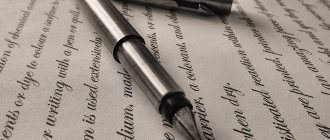The ability to write beautifully is considered a real art, for which a separate term was even created - “calligraphy”. But to achieve success in penmanship, it is not at all necessary to have special talents. All you have to do is be patient and learn a few simple penmanship lessons. In this article we will tell you how to learn to write beautifully and provide step-by-step instructions for improving your handwriting.
Decide why you need it
There can be different reasons for wanting to improve your handwriting.
And you should find yours. Firstly, it will make you act more consciously and increase motivation. And secondly, it will tell you which handwriting nuances you need to focus on correcting. Perhaps you just want to write more legibly. Or you feel the need to make your handwriting more “authoritative”—to give it confidence, clarity, and effectiveness. Or maybe you are driven solely by an aesthetic feeling. Understand yourself, this is important.
Writing capital letters.
If the capital letters are noticeably enlarged, this indicates a person’s pride (maybe even excessive), his self-confidence and independent thinking, and his desire to stand out. The desire to attract attention and sociability is also indicated by a large loop in the capital letter.
If the capital letters are relatively small in size, the person does not seek to be noticed, takes small and careful steps in life, always adhering to his convictions.
The use of printed capital letters in handwriting characterizes a person as creative, inventive, with a flexible mind and good sensitivity.
Adding eye-catching curls and other decorative elements to capital letters indicates either a need to attract attention or a romantic mindset.
Evaluate your current handwriting
Take a piece of paper and write a few sentences on it so that they form two or three paragraphs. Don’t try to write letters “beautifully”, write naturally - the way you always do it.
When finished, place the sheet in front of you and analyze the visible flaws in your handwriting. Do this not in general (“like a chicken paw!”), but trying to highlight specific points.
- Letter shape. Perhaps they are too narrow and angular? Or, on the contrary, overly rounded, with intricate loops? Maybe they duplicate each other - for example, “p” in your version looks like “i”?
- Incline. In classic beautiful handwriting, all letters have the same slight slant to the right.
- Letter height Ideally, it should be the same and such that the icons are readable. And how are you?
- Writing letters. When analyzing, it may turn out that you depict the same element in different ways. A classic example is the difference in the style of the letter “t”: sometimes the printed version is used, and sometimes the written version is used.
- Spacing between letters. It should also be uniform.
- The placement of letters horizontally. They should not jump or go up and down towards the end of the line.
- Pressure. The pressure of the pen on the paper should be uniform throughout the text. But it often happens that in one place we put too much pressure on the pen, and in another, on the contrary, it seems to slide off the paper, which is why the text looks sloppy and difficult to read.
For clarity, you can highlight or outline the most “prominent” areas of the text with a contrasting color. This will help you focus on those shortcomings that you want to get rid of. For example, if you notice that the letter “w” comes out crumpled and compressed at the end, in the future you will try to make it more uniform.
Why is it important to be able to write beautifully and quickly?
It may seem to some that teaching a child to write beautifully or mastering this skill personally is not a very relevant task in the modern world. After all, now most text goes through gadgets and computers; people hold a pencil in their hands less and less often. But here are just some arguments why you need to learn to write beautifully:
- Scientists have proven that writing by hand helps develop mental abilities and the entire brain. Neuroscientists say that writing perfectly develops fine motor skills of the hands and strengthens connections between neurons in the brain. A person who writes a lot is generally more developed;
- Beautiful handwriting makes it easy to write information down on paper and also easy to re-read it. There are often cases when a person supposedly knows how to write, but has difficulty reading what he has written with his own hands. This looks strange and needs fixing.
Learn to write beautifully
It is necessary to be able to write legibly and clearly, because gadgets, Google, voice prompts and other joys of modern civilization may not always be at hand.
Find inspiration
Beauty is a relative concept, and “beautiful” (in your opinion) handwriting can be completely different. Look for an example of one you like.
Perhaps these will just be perfectly even “school” lines:
900igr.net
Or elegant calligraphic:
Youtube channel AlphabetMan
Or maybe you crave originality and prefer handwriting slanted to the left? If possible, print out the examples you find and place them where you can see them. For example, hang it on the refrigerator door. Attach it as a sticker to your monitor. Or above the desktop.
This will help “correct” handwriting stick in your visual memory and encourage you to subconsciously copy “good” examples.
Advice for adults
It is difficult for adults to relearn writing. If a person is used to writing quickly in an incomprehensible handwriting, then it will be difficult for him to switch to smooth calligraphy with every line drawn.
Note! Many people think that it is easier for girls to learn beautiful handwriting. This is due to perseverance, diligence and desire. Guys often give up halfway, although everything comes much easier to them.
Writing Tips for Adults:
- Choosing a pen that will fit perfectly in your hand.
- There should be a sheet of paper and a pen at the workplace, nothing more.
- The correct position is a straight back, hands on the table.
- The leaf should be 30 cm from the eyes.
- When writing, you need to write letters several times to choose the most successful option.
- Daily writing. You need to write every day. It is better to keep a special note with articles and essays written by hand.
Not many people are gifted with beautiful writing, but if you try, you can learn it. In order for it to be literate and without errors, it is important to read different books and poems.
A well-read person does not make mistakes on a subconscious level and writes words correctly.
Remember that beautiful calligraphic handwriting can create a good impression of others about you.
Useful video
Share this post
- Related Posts
- What does fly agaric tincture help with and how to make a decoction
- What to do when you're bored: ideas for activities, interesting sites and ways to spend time usefully
- Zircon: plant growth stimulator, application
- Shine from an iron: how to remove it from black clothes, how to remove it from trousers, and how to remove it from synthetics
- How to make a phone case with your own hands from paper, felt and leather
- Touching, beautiful, funny, original birthday greetings to your beloved man
Do exercises for your hands
Handwriting is responsible for what physiologists call fine motor skills - a set of coordinated actions of the hand and fingers. If you try hard, but your handwriting is in trouble, then perhaps the problem is in your motor skills. There is only one way out: train your hands.
Among the most effective and at the same time simplest methods is air letter. Take a pen or pencil, bend your elbow (at an angle of about 70-80 degrees) and start writing imaginary words in the air. Make the letters large - in this case, when writing, not only the hand and fingers will be involved, but also the entire limb from the shoulder, including the wrist and forearm. This is important: you will tire less if you write with your whole hand, and this will keep your handwriting clearer and more even.
Such exercises should be done regularly. For example, spend 3-5 minutes on them in the morning, afternoon and evening.
How long does it take to change your writing style?
The rate of change will depend on three factors:
- final goal;
- teaching methods;
- pure practice time.
If you are faced with the task of radically changing your writing style, do not expect quick results. It will take 2-3 months to get used to writing numbers and letters in a new way, forming the individual beauty of handwriting.
Daily exercise is important: even for 5 minutes, but every day.
If a small correction is required, the first successes can be noticed after 3-4 weeks, but only if the training method is chosen correctly. On average, teachers provide the following data: by studying for 8 hours daily, the first results can be seen within a month.
Make sure you are holding your pen or pencil correctly
YouTube channel “I want to know everything”
The writing utensil should lie on the left side of the middle finger of your right hand (if you are left-handed, on the right side of the middle finger of your left hand). The tip of the index finger holds the pen or pencil on top. The large one supports on the left (for left-handed people - on the right). When you write, your hand should rest on the top joint of your bent little finger.
All three fingers holding a pen or pencil are slightly rounded and do not grip the stationery too tightly.
To check your grip is correct, lift your index finger. The pen (pencil) should not fall.
Where do legs come from?
Calligraphy is an art form that dates back to ancient times. Modern researchers distinguish the following types of calligraphy:
- Western (European);
- East Asian;
- Arabic
There are many subtypes of calligraphy, each of which has its own history, distinctive style and character, and is still the object of study by archaeologists. Let's take a closer look at the three main types of calligraphy.
European calligraphy
The first cuneiform writing system in human history is considered to be Sumerian. It arose in the 4th-3rd millennium BC. Then clay was used as the main material for writing hieroglyphs. Basically, words were depicted in the form of puzzles: with the help of signs that have a certain sound, a word was composed.
This type of writing was called cuneiform, because. the hieroglyphs consisted of a set of dashes with a wedge-shaped thickening. Cuneiform consisted of 900 characters; over time, the system of drawing letters became more complex and was finally supplanted by other types of writing.
The Sumerian script was replaced by the Egyptian hieroglyphic script, the alphabet of which consisted of 600 characters. These signs clearly conveyed the images of what the person wanted to say: coolness was depicted in the form of a vase from which water flows, the south was indicated by a lily (this flower was depicted on the coat of arms of Southern Egypt).
Thanks to the development of cursive writing, the first schools of demotic writing began to appear in Egypt - this is one of the forms of Egyptian writing that was used to write texts in the later stages of the development of the Egyptian language. According to some sources, calligraphy competitions were already held in those days.
Further, as a result of the borrowing and transformation of the Phoenician alphabet by the Greeks, the Greek letter arose. The Greeks supplemented the alphabet with various signs and sounds, geometric shapes, due to which it became simpler. Greek writing was originally left-handed, but soon became right-handed. As a result of the development of Greek writing, the direction of writing in the Latin alphabet changed.
Majuscule and minuscule Roman cursives appeared thanks to the materials that were used for writing at that time: the Romans wrote on a waxed wooden tablet with a pointed stick. When writing quickly, some letters were skipped, so in order to connect the letters with each other, strokes were added, some letters were written higher than others, and the letter itself began to acquire a slant [V. Toots, 1966].
The Roman italics and Roman capital letters were replaced by the uncial letter, which became the main one in writing books. Almost all the literature that has survived from those times is written in uncial (from the Latin uncialis - “equal in length to one ounce”) - a type of writing in which all the letters are round, without broken lines or sharp corners. Uncial writing primarily refers to the majuscule type of writing.
Over time, the uncial script began to take on the outlines of italics and eventually began to resemble lowercase italics. This is how semi-uncial writing appeared, as a result of which writing and reading became much easier [M. Couch, 1998].
Merovingian and Visigothic writing arose in the 8th and 9th centuries as a result of the spread of Christianity in Gaul. They are based on early Roman italics. In appearance, such letters looked compressed, the letters were tall and intertwined, so it was difficult to read the inscriptions, although they looked decorative.
Further, on the basis of the uncial and capital letters, the Old Italic letter began to develop, and after that the Gothic letter appeared, which is characterized by pointed forms that replaced the usual rounding.
The Gothic style became the main one in Europe, but not in Rus', where the development of writing occurred differently: in the process of improving society and religion, the Glagolitic alphabet appeared, which was not easy to use. Later, the Cyrillic alphabet arose - one of the types of writing, named after its creator Cyril (who worked in collaboration with Methodius), and with the development of printed materials, ligature appeared - a more decorative type of writing, which adorned the covers of books and other publications [O. Voloshina, 2009].
The Gothic style is widely used in writing to this day, it is characterized by condensed letters that allow more text to fit on one line, dark lettering and angularity. In different countries, such writing acquired its own characteristic features, and only the Spaniards developed the strictest style of Gothic writing:
In Italy, thanks to the development of the Gothic style, a round Gothic letter appeared - rotunda. It is considered one of the most beautiful writing styles in Western Europe [V. Toots, 1966].
East Asian calligraphy
Calligraphy appeared in Japan in the 7th century and was based on Chinese writing styles, i.e. on hieroglyphs. But the Japanese transformed it and filled it with emotion and philosophy. Separate styles of calligraphy emerged (kabuki-moji and jo-ruri-moji), which were used in posters and theater programs:
Japanese calligraphy is still developing today. In 1948, the Association of Masters of Modern Calligraphy was created, which currently operates and is one of the leading calligraphic associations. The Association annually organizes exhibitions where contemporary authors demonstrate their works.
In the 20th century, Japanese calligraphy was a “game of brush and ink”, it looked dynamic and enlarged, and later abstract calligraphy appeared: here hieroglyphs no longer carried a semantic load, calligraphers began to improvise more [search.rsl.ru, 2008].
Arabic calligraphy
Arabic calligraphy originally arose from the process of copying the Qur'an and therefore occupies an important place in Islamic art. Medieval rulers gave lunch to copy the Koran, but to do this they had to learn calligraphy. The Baghdad caliphs began to create libraries and build centers in which those who translated and rewrote the holy scriptures worked.
Calligraphy became the basis for the sacrament of writing words, to which the Arabs attached a special sacred meaning. This style even became an exception to the rule: the Koran prohibits depicting people, animals or Allah, because... it is believed that in this case people worship not Allah, but the picture. At the same time, calligraphy is allowed to write words that form images.
Some calligraphers used only the ink that had been in Mecca to create copies of the Koran. Initially, only the Hijazi style was used, but then, as new handwritings emerged, six variants of writing the text appeared, they were called the “magnificent six.”
It is noteworthy that the Arabs treated calligraphy as an exact science, and created a number of rules for writing letters that all masters in this matter had to follow:
The most famous Arabic calligraphers are: Khalid ibn al-Hayyaj, Ahmed al-Kalbi, Fatima al-Baghdadi, etc. Yakuta al-Mustasimi is considered the best calligrapher of that time; he developed a system of calligraphy styles and a methodology for teaching this craft [O. Bibikova, 2005].
As you can see, calligraphy had three different directions of development and still continues to improve in the hands of its masters, conveying all the flavor of the people of its creator.
Practice writing basic lines
Before you start drawing beautiful letters, make sure your hand remembers how to write the basic elements. We are talking about simple vertical and diagonal lines, circles, semicircles.
Only after you learn how to automatically display precise lines and curls should you move on to the text.
You can train using special recipes, including those designed for future first-graders. Such manuals are sold in office supply stores and on the Internet. A big plus of copybooks is that they are marked with lines that will help you control the slope and size of your elements.
labirint.ru
Another option to improve your skills is doodling. This is the name for an amateur drawing technique based on intuitively selected patterns. You can do doodling anywhere: at a meeting, on public transport, while talking on the phone. All you need is a pen and a notepad, the pages of which you will fill with intuitive patterns.
YouTube channel camellia8885
Doodling develops coordination of movements and the habit of smoothly moving a pen or pencil on paper. And with this technique you can create real masterpieces. But that's a slightly different story.
Roundness of letters.
“Round” handwriting indicates a person’s tendency to soften contradictions, make compromises, and be stable in his opinions and tastes.
If you come across angular capital letters in rounded handwriting, then you are probably dealing with a rather soft person who can be persistent and aggressive in certain situations.
“Angular” handwriting indicates that its owner is characterized by harshness, demandingness, and stubbornness. However, at the same time, he has such advantages as determination, energy, and the ability to work hard. Such people often show a desire for leadership.
Advertising
Secrets for beginners in calligraphy
You need to remove the oil coating from the new feather, then it will glide better. Wipe the pen with a cloth soaked in alcohol.
If the ink does not leave a mark on the paper, simply touch the tip of the pen to the surface of the water, this will help the ink transfer to the paper better.
If the letters come out too thick and uneven, try working a little faster. If the speed is slow, excess ink may spill onto the paper.
If you draw a line up, it should be thick, and the line that goes down should be thin. This is difficult to remember, but easy to practice. Usually everyone gets it done pretty quickly.
Undeveloped motor skills
If elements with curved lines are very distorted, the child most likely has problems with fine motor skills.
Such children “crawl out” beyond the line, their letters are too large or small, and the lines seem to consist of multiple zigzags. Fine motor skills refer to the mobility of fingers and hands. This is an important factor in the child’s readiness to study at school. As a rule, most children experience some difficulty with coordination of movements. Fortunately, the problem is solved quite simply: you need to constantly train, performing special exercises. Before a writing lesson, the teacher usually conducts finger gymnastics, which is included in the teaching methodology for primary school. The exercises may be difficult at first, but doing them regularly will eventually reward you with excellent results.
So, if your son or daughter is experiencing similar difficulties, you need to more often play games aimed at developing fine motor skills. There are a variety of exercises. You can improve your child’s handwriting with the game “Twister”. You need to place a field on the table. The hand with which the baby writes will “dance”, demonstrating various movements, while the other hand can be used to throw the dice. The algorithm is as follows:
- The first player (this could be a parent) rolls two dice at the same time and says which finger he got (drawn white on a dark hand) and color. If the light palm falls out, you can “dance” on the field with the finger with which it is most convenient to do this.
- The second player (child) performs his task, focusing on the thrown dice.
- After this, the participants continue to perform tasks without taking their fingers off the field. Anyone who fails to take the required position is eliminated. Accordingly, the one remaining on the playing field is considered the winner.
Website: https://msk.etginpro.ru Phone: Cost: from 280 rub. per lesson
Handwriting correction courses at InPro
offers handwriting correction services for primary and secondary school children. In classes, a child can quickly master and practically consolidate the rules of penmanship.
The main advantages of training at InPro are:
- Choice of individual or group type of training;
- High efficiency;
- Convenient payment system and affordable cost;
- Possibility of attending a free trial lesson;
- Convenient learning conditions;
- Flexible class schedule;
- Individual approach to students;
- Guaranteed quality results;
- Availability of favorable discounts.
If desired, the parent can choose individual lessons, group training or online classes. It should be noted that the school provides special discounts for teaching children penmanship in groups of 2-4 people.
Body position and inappropriate desk
Poor handwriting is often caused by poor posture, unnatural pen angle or notebook placement. In order to write quickly and clearly, you need to follow these rules . You need to sit straight so that your torso, shoulders and head are in a level position. Your back rests on the back of the chair, your feet are on the floor. Under no circumstances should your chest touch the table; your elbows should go beyond its edge.
Children often sit in the wrong way, copying their neighbor at the desk. They easily forget what their parents told them at home. To accustom your baby to the correct position, you need to spend some time on this and explain that the body quickly gets used to the correct position. The child must understand that discomfort will be felt only at first, and then addiction will set in, after which he will no longer have to make any efforts and control himself.
School desks are made to an accepted standard, so they cannot be incorrect. In accordance with the standards, the tabletop should be located slightly below the solar plexus and have a slight angle. The desk itself has a durable and stable design. If parents doubt its quality, they can attend a lesson and make sure that everything is fine, or transplant the baby to where it will be better for him. Children have different heights, so the teacher selects the most suitable place for each child. Well, at home you need to properly organize the student’s workplace.
Summarize
And yet, despite the development of information technology, handwritten letters will always be in demand. After all, this is real art - to write as if you were drawing out the details of a picture, putting all your soul and inspiration into it. It’s not for nothing that the process of creating calligraphy is compared to meditation: the brain is completely abstracted from the outside world, and all thoughts are concentrated on creating beauty. An excellent means of relaxation!
Unlike many types of art, calligraphy does not require any special training, education, or even beautiful handwriting to begin with. Absolutely anyone can learn it, you just need to arm yourself with desire, patience, time and the necessary tools for practice.
Let creativity into your life, try writing your favorite phrase in calligraphy, and you will feel how seemingly the simplest letters can give energy and inspire new achievements.
We wish you interesting ideas and success!
We also recommend reading:
- Storytelling
- Time capsule to yourself
- Habits that separate the writer from the imitator
- Tips for Improving Non-Fiction Writing
- Creative Writing Ideas and Tools
- Creative Writing Ideas
- 8 Reasons to Practice Creative Writing
- 20 interesting facts about the Russian language
- How to Improve Your Writing Skills
- Lettering: art in letters
- Lettering: freedom of speech for the artist
Keywords:1LLL










